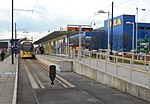Oldham Above Town
Oldham Above Town was, from 1851 until 1905, a statistical unit used for the gathering and organising of civil registration information, and output of census information. It was a sub-district of the larger registration district of Oldham, in the then registration county of Lancashire, in England.Unlike neighbouring Oldham Below Town, the area was broadly rural and encompassed a number of small settlements and hamlets in the Pennine hills and moorland, north east of Oldham town centre. The district stretched from parts of Mumps, through Greenacres to Lees, including the areas of Salem, Waterhead, New Bank, Watersheddings, and part of what is now considered Lees. In 1905 the Above Town and Below Town subdistricts were replaced by Oldham Central, Oldham East and Oldham South.Oldham Above Town appears on several England and Wales census transcripts/returns as a place of birth and dwelling for many people of Oldham.
Excerpt from the Wikipedia article Oldham Above Town (License: CC BY-SA 3.0, Authors).Oldham Above Town
Dale Grove, Tameside Hurst
Geographical coordinates (GPS) Address Nearby Places Show on map
Geographical coordinates (GPS)
| Latitude | Longitude |
|---|---|
| N 53.5 ° | E -2.1 ° |
Address
Dale Grove
Dale Grove
OL7 9RG Tameside, Hurst
England, United Kingdom
Open on Google Maps






